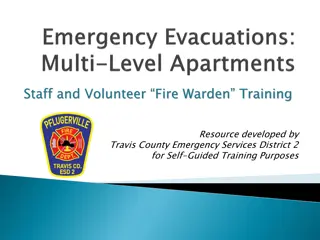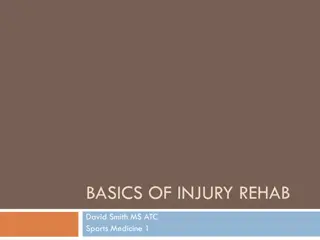Firefighter Rehab Training by Shepherdstown Fire Department: Ensuring Safety and Health Standards
This training program by Shepherdstown Fire Department focuses on implementing Firefighter Rehabilitation protocols at emergency scenes, providing direction for personnel and Incident Commanders per NFPA guidelines. It emphasizes the establishment of formal rehabilitation in specific incident conditions to safeguard the well-being of firefighters and EMS providers.
Download Presentation

Please find below an Image/Link to download the presentation.
The content on the website is provided AS IS for your information and personal use only. It may not be sold, licensed, or shared on other websites without obtaining consent from the author.If you encounter any issues during the download, it is possible that the publisher has removed the file from their server.
You are allowed to download the files provided on this website for personal or commercial use, subject to the condition that they are used lawfully. All files are the property of their respective owners.
The content on the website is provided AS IS for your information and personal use only. It may not be sold, licensed, or shared on other websites without obtaining consent from the author.
E N D
Presentation Transcript
Firefighter Rehab Training Shepherdstown Fire Department, Inc. Educational Institution April 2019
Agenda 1. Standard for Rehabilitation Establishment 2. Standard for Personnel Reporting to Rehab 3. Standard for Location of Rehab 4. Standard for Minimum Rehab Resources 5. Standard for Rehab Monitoring 6. Standard for Treat and Release per the Medical Director 7. Standard for Denial of Return to Duty 8. Standard for Return to Duty 9. Standard to Transport to Hospital for Evaluation, Automatic Transport Criteria (ATC)
Marshall DeMeritt, MS, NREMT Grew up on a goat farm in Luray, VA Undergraduate Degree from Shepherd University Joined Shepherdstown Fire Department in 2006 Elected as EMS Chief in 2014 Master of Science from WVU WV Office of EMS Emergency Medical Technician National Registry Emergency Medical Technician National Association of EMS Educators Instructor WV Office of EMS Lead Instructor Firefighter, Fire Officer II, and Rescue Technician Father of 3 (2 + a dog), Husband to Krystle
Purpose This training is to provide Jefferson County Fire and EMS personnel and Incident Commanders with direction on the implementation and use of Firefighter Rehabilitation at the scene of fires, other emergency incident scenes, and during training, per NFPA 1584 (2008). It shall provide direction as to what activities are to be undertaken by each component of the fire ground and the EMS providers assigned to work in the rehab sector. These guideline used to develop this training (OG 16-018) includes when to restrict members from returning to duty for medical reasons and when to transport for additional treatment. It shall also provide guidance to those members reporting to rehab as to what their responsibilities are, and what to expect of the process.
Standard for Rehabilitation Establishment Shepherdstown Fire Department Educational Institution
Formal Rehabilitation should be established on all incidents in which one or more of the following are present: Operational period greater than forty-five (45) minutes. Greater than twenty (20) Operational Personnel on scene. Any incident in which an area (sector) has been determined Immediately Dangerous to Life and Health (IDLH). At the discretion of the Incident Commander or commanding officer. Rehabilitation Establishment
Company/Unit officers shall monitor members under their command Members shall also monitor themselves and each other even without the formality of a rehabilitation program. Members should request rehab from their company/unit officer if they feel they are in need (illnesses, injuries, or other conditions). Company/Unit officers should request rehab be established if they feel their company member(s) are in need. Do not let a lack of formal rehab keep Illnesses, injuries, or other conditions from being reported immediately.
Standard for Location of Rehab Shepherdstown Fire Department Educational Institution
Standard for Location of Rehab Be away from smoke or other irritant and provide comfortable breathing conditions removed from the hazards of the incident scene including smoke, vehicle exhaust, and excess noise. Be completely segregated from media and spectators. Provide protection from weather extremes (direct sun, rain, etc). Be accessible to emergency medical transport vehicles.
Standard for Location of Rehab Be of a size large enough to facilitate the expected number of personnel - including members working in the rehab area. Have a separate area for doffing and storing PPE, and replacing air bottles. Have an adequate supply of drinking water, sports drinks for electrolyte replacement and food for calorie replacement - especially during incidents longer than three hours.
Standard for Location of Rehab What s Wrong Here?
Standard for Location of Rehab What s Wrong Here?
Standard for Location of Rehab What s Wrong Here?
Standard for Minimum Rehab Resources Shepherdstown Fire Department Educational Institution
The Incident Commander, Medical Group Supervisor or Rehab Officer shall ensure the Rehab location provides for the following elements: Medical monitoring At a minimum, the rehab facility shall provide a Lifepack 15 and/or the ability to monitor the blood pressure, pulse, SP02, respirations, and CO of a firefighter. Emergency Medical Care and Transport At minimum, the rehab location will provide general care and treatment tools for the treatment of basic medical emergencies and traumatic injuries (AED, trauma dressings, Oxygen, etc). Immediate access to an Ambulance. Hydration to replace lost fluids - Members should drink at least 8-16 oz. water or electrolyte sports drink in the 20 minutes they are in rehab. Cooling and/or Warming capabilities. Relief from weather extremes (heat, cold, direct sun, rain, snow, wind) Food shall be provided during incidents lasting in excess of 3 hours. Accountability - Individual units are to report to rehab as a group, and are to remain together during rehab. All personnel reporting to rehab should be documented for accountability purposes. Standard for Rehab Resources
Standard for Personnel Reporting to Rehab Shepherdstown Fire Department Educational Institution
Standard for Personnel Reporting to Rehab All personnel operating within an area that is deemed as IDLH must report to rehab within the confines of the incident operations period, and preferably immediately upon exiting the IDLH. Any personnel completing one (1) hour of SCBA use should report to rehab. It is the responsibility of the Incident Commander, and the unit officer to ensure all personnel have reported to rehab. The Rehab Officer or Medical Group Supervisor must ensure appropriate tracking and documentation of all personnel reporting to rehab.
Why Report to Rehab? County Standard dictates your compliance. A report by the Illinois Fire Service Institute (IFSI) documents a firefighters average heart rate when exerting themselves during overhaul: 175 bpm Further, the IFSI report suggests that firefighters lose nearly two quarts of sweat per hour when firefighting. Firefighter rehab, along with a healthy lifestyle and diet, could go a long way toward reducing fatalities and injuries.
Standard for Rehab Monitoring Shepherdstown Fire Department Educational Institution
Standard for Rehab Monitoring The Incident Commander, Medical Group Supervisor or Rehab Officer shall ensure the EMS providers facilitating rehab provide the following monitoring: Members shall be checked into rehab by EMS workers in the rehab sector and shall have their department, unit, name, and the time of entry recorded on the EMS REHAB FORM. Vitals shall be recorded on the EMS REHAB FORM. Vital signs and assessments made will include blood pressure, pulse, SP02/CO, and Temp. Presence of any trauma and/or other conditions will be noted on the form, and appropriate care established. EMS providers will perform a basic medical and trauma assessment on all personnel entering rehab, and document any findings.
Standard for Return to Duty Shepherdstown Fire Department Educational Institution
Standard for Rehab Monitoring All Members will be required to maintain a presence in rehab for 20 minutes of monitoring, or until emergency operations have ceased, whichever is sooner. If after a 20 minute monitoring period the member exhibits appropriate signs and symptoms, they shall be released to return to full duty: Pulse less than 120 beats per minute. Respirations greater than 10, less than 20 per minute. Blood Pressure less than 160 systolic and 100 diastolic. SPO2 greater than 94% CO level of <5% in nonsmokers or <10% in smokers
Standard for Rehab Monitoring The Medical Group Supervisor or Rehab Officer shall collect the documentation from the EMS providers, and will complete a single ePCR within ESO to document the Rehab completion. The forms utilized in the completion of Rehab will be scanned and attached to the ePCR. NOTE: In the event a firefighter is transport from the scene, a ePCR must be completed for the transport, and a separate ePCR for the rehab operations.
Standard for Treat and Release Shepherdstown Fire Department Educational Institution
Standard for Treat and Release Per the Medical Director, Paramedics have the authority to begin IV therapy to personnel in Rehab, without the requirements to transport under the following conditions: The firefighter is able to orally hydrate simultaneously to the IV NS. After 1L NS is administered, the firefighter conditions have improved. Per the Medical Director, EMS providers can provide personnel in rehab Oxygen and certain Over-The-Counter (OTC) medications without the obligation to transport. OTC medications such as Tylenol or Motrin for the treatment of minor aches and pains. Oxygen for the treatment of minor respiratory issues, with an improvement in vitals following administration.
Standard for Denial of Return to Duty Shepherdstown Fire Department Educational Institution
Standard for Denial to Return The Medical Group Supervisor, Rehab Officer or EMS Provider, with the authority of the Incident Commander, shall remove any firefighter from active duty if any of the following are determined: Vomiting, diarrhea, heat exhaustion Large open wounds Insulin dependent diabetic has not eaten in 4 hours Wheezing/congestion, unimproved by oxygen Pulse above 120 per minute after 20 minutes of rest. Respirations over 20 per minute after 20 minutes of rest. Blood Pressure above 160 systolic or 100 diastolic after 20 minutes rest.CO level of >5% in nonsmokers or >10% in smokers after 20 minutes of rest. SP02 less than 94% after 20 minutes of rest. Other conditions as appropriate, at the discretion of Medical Group Supervisor, Rehab Officer or EMS Provider.
Standard for Denial to Return In the event any of the listed signs/symptoms are present, the MBR shall have vitals/assessments re-assessed every 5 minutes to determine appropriate additional actions. Any member not meeting specific health criteria shall not be permitted to return to the incident and will be further monitored or transported.
Standard for Automatic Transport (ATC) Shepherdstown Fire Department Educational Institution
Standard for ATC The Medical Group Supervisor, Rehab Officer or EMS Provider, with the authority of the Incident Commander, shall direct the transport of any firefighter from the scene to a Emergency Department if any of the following are determined: Symptoms of heat stroke or hypothermia Continued Shortness of Breath or Trouble Breathing Abnormal lung sounds or extremely low SPO2 or high CO readings Syncope, altered mental status, confusion, disorientation Irregular pulse and/or persistent pulse above 180 Significant injury (fracture, uncontrolled bleeding, etc.) Chest pain or severe headache No improvement in other noted vitals or signs/symptoms after 20 minutes.
At no time should this guideline or training supersede the local EMS protocols or other directives from the Squad Medical Director
Questions? Shepherdstown Fire Department Educational Institution Contact Information: Marshall DeMeritt, MS, NREMT EMS Chief, Shepherdstown Fire Department emschief@shepherdstownfiredepartment.com (540)742-8190























